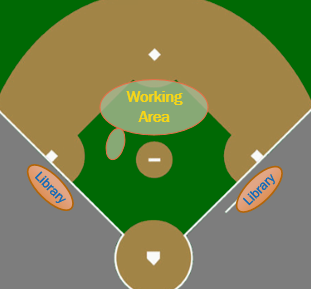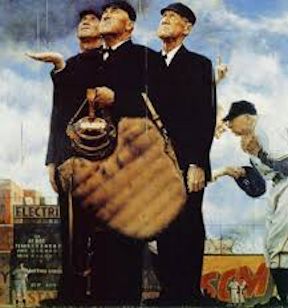 Working Area & The Library
Working Area & The Library

In addition to knowing the start positions and basic rotations, the base umpire (U1) must also be familiar with the working area and the library. While the library comes into play primarily with larger crews employing three- and four-man mechanics, the working area is important with all crew configurations.
Working Area
The working area is your friend. When your start position is B or C, most of your responsibilities are going to take place in the working area.
The illustration depicts the working area on the infield, behind the pitcher's mound, and ranging to left and right. However, the boundaries in the oval shown here are not etched in stone. From a position between the mound and second base, and extending toward the first and third base lines, you slide left and right to get the proper angle on the plays that you're responsible for.
That little tail on the working area that you see between the mound and third base is an extension that you move into when you have a play at third. Notice that when you move from the working area into the tail, you don't want to move parallel to the baseline. Rather, move toward a point midway between third and home. This gives you a far better angle on a play at third.
Areas of responsibility for the field umpire that normally take place in the working area include these:
- All plays at all bases, except ... On a two-man crew, you have all plays at all bases, except when you are in a first-to-third situation. We talk about that exception elsewhere. With multiple runners, though, you need a head on a swivel, as they say, and you need to stay with the ball.
- Plays at third base. Plays at third will draw you out of the working area to the tail we talked about. Notice (and this is important) that U1 does not move in a line parallel to the base path when getting set for a play at third. Instead, he moves in the direction of the home team dugout so that he gets a good angle on the play at third. However (this is important): don't go deep into a play at third if there are other runners advancing. You may need to be able to quickly pivot and pick up a play at second.
- Base touches and tag-ups. You have responsibility for tag-ups and base touches on all runners at all bases. This changes when there are multiple runners; in that case the plate umpire has touches and tags at third base.
- Catch/no-catch in the cone. You should drift in the working area to best position yourself for the catch/no-catch call and (to the best of your ability) to also line yourself up to see the runner on second (R2) tag up.
- Catch/no-catch of pop-ups to the infield. The PU has most catch/no-catch calls on fly balls to the infield, but pop-ups that bring the fielder right to your position belong to you. We talk about this in more detail in the article Catch/No-Catch Coverage.
Don't get sucked into a play at a base. What does this mean? It means that with multiple runners and the potential for multiple plays in quick succession, you don't want to get sucked too far into any one of these plays. Sacrifice distance to maintain your angles. For example, if there is a play at third, and you hustle to get close for the play, and then there is a quick throw to get a runner advancing to second, you're going to have a terrible angle on (and may end up screwing up) the play at second. Stay in the working area when there are multiple runners and position yourself to get good angles rather then close distance.
The Library
The library does not come into play in two-man mechancics, but it is such an integral part of three- and four-man mechanics that it's important that you're familiar with it. And where did "the library" get it's name? It's called the library because it's an intermediate position where an umpire pauses to literally read the action and prepare to then rotate as action on the field dictates.
In three- and four-man rotations, on balls hit to the outfield, the umpires in A and D positions frequently complete an initial assignment (for example, U1 gets the batter-runner's base touch at first), then releases the runner and drops into the library to read the action, and then, if necessary, rotates down to home plate (that is, when the PU has rotated up to third).
This is just one hypothetical scenario of a great many that employ make use of the library.

